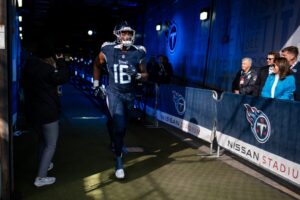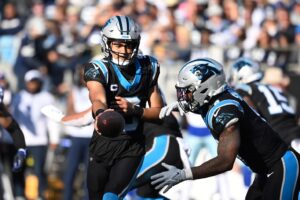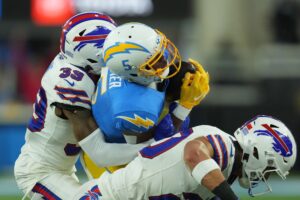The Green Bay Packers have many questions to answer during the offseason, including who will be the starting running back next season. This past season, Green Bay went through a revolving door of running backs before landing on Ty Montgomery, but is the former Stanford wide receiver converted running back enough to propel the Packers back in the Super Bowl? What other options should the Packers explore via the draft, and free agency? Here is an analysis of the Green Bay Packers running back situation.
Analysis of the Green Bay Packers running back situation
Since the Packers are a pass-first team, they do not need a stout run game like the Dallas Cowboys, or Minnesota Vikings. However, over the last two seasons, despite Aaron Rodgers’ miracles, everyone saw how important a decent run game can be. The running game becomes so important in the playoffs. It keeps the defense off of the field, wears down the opposing team, and makes the offense two-dimensional therefore better.
Eddie Lacy
What has happened to the Alabama Crimson Tide alumni? He registered back-to-back campaigns with over 1,100 yards to begin his career. But, since those seasons, one of which earned him a nod in the Pro Bowl, the Gretna, Louisiana native has struggled mightily.
In 2015, he arrived at training camp out of shape. Lacy has never been a fit running back and even said, per ESPN, “[…] I’m just saying, not everybody is meant to look like Adrian Peterson or somebody like that.”
This past offseason, he got in tremendous shape working with P90X creator Tony Horton. The results were staggering; Eddie Lacy looked like a new man. But, Lacy was not disciplined enough to maintain is fitness level, and by season’s end, ESPN reported that he weighted between 255 and 265 pounds.
Per Pete Dougherty for USA Today, “From what I’ve been able to find out, coach Mike McCarthy fined Lacy for not making weight over the last couple seasons, though it’s unclear how often or how much. Whatever the extent, it didn’t work.”
Despite his reckless attitude towards his body, Lacy was running the ball with effectiveness and authority. He showed versatility by running through defenders and made tacklers miss to gain yardage. The former pro bowler was enjoying his most successful campaign to date, but unfortunately, it ended after five games.
Lacy totaled 360 yards on 71 carries, which averages out to 5.1 yards per carry. His career-best was 4.6 set in 2014; however, he was below his career-best in yards per game (72 vs. 78.5). In fairness to Lacy, he tends to be a slow starter but finishes strong a la LeGarrette Blount in New England.
Lacy, like Blount, are bigger backs that embrace their size and strength to bulldoze their way through defenders afraid of tackling them in cold weather games. He also helps the Packers run the clock in the fourth quarter, an important ingredient for a winning recipe. For example, in a week three game against the Detroit Lions, Green Bay jumped out to a 31-10 halftime lead; however, due to their ineffective run game, the Packers were unable to run out the clock in the second half, and Matthew Stafford failed a touchdown short of an unbelievable comeback.
The combination of a season-ending injury in a contract year and a year spent in Mike McCarthy’s doghouse could spell trouble for Lacy’s long-term future in Green Bay.
At this point, it is highly unlikely that the Packers will sign him to a long-term contract. If they are to re-sign him, it will be a one-year prove it kind of deal, which would probably be between one and two million dollars, and maybe some incentives.
Ty Montgomery
Ty Montgomery, the wide-receiver-turned-running-back midway through the season became a temporary solution that will end up being permanent. Per Ryan Wood, Green Bay Packers beat writer for the Green Bay Press Gazette, and Josh Alper of Pro Football Talk.
McCarthy said #Packers RB Ty Montgomery will stick at RB. "He's a running back. He wants to change his number."
— Ryan Wood (@ByRyanWood) January 26, 2017
Montgomery was a great surprise, but with a lot film and an offseason to prepare for him, it will be harder to run the ball. Since Montgomery was not a running back, coach Mike McCarthy called mostly ‘G runs’, outside-zone, and stretch ‘G’ or ‘C’ run schemes to make it easier on him.
Matt Bowen, a seven-year NFL veteran, who covers the NFL for Bleacher Report, breaks down the ‘G runs’, outside-zone, and stretch G or C run concepts.
‘G runs’ is typically run out of a two-back system with the strong side guard pulling to block the primary defender, and the fullback leading up the hole to block the linebacker.
Outside-zone running scheme is very common in the NFL as it can be used “from a shotgun alignment, pistol, or with the back in the ‘dot’ (aligned directly behind the quarterback under center) out of Jet/10 (4WR-1RB), Posse/11 (3WR-1TE-1RB), Ace/12 (2WR-2TE-1RB), or Heavy/13 (1WR-3TE-1RB) personnel groupings,” writes Bowen.
The strong side of the offensive line blocks their respective men in unison, while the backside blocks their respective men with the backside tight end chipping the defensive end. The running back has the option to either run behind the strong side of the offensive line or cut the center for a more vertical run.
“Stretch ‘G’ or ‘C’ is another zone-blocking scheme (same technique as the one-back outside zone) with the play-side guard “G” pulling to block the first defender who shows in his gap. Teams will also use the stretch “C” and pull the center to the edge of the formation to target the primary edge support player,” writes Bowen.
The “Ghost” outside-zone blocking scheme is similar to the outside-zone scheme. The difference is the offense will send a wide receiver in motion to freeze up the backside defensive end, which will give the running back the option to run to the strong side or the backside.
While Montgomery was a nice story in the middle of a roller coaster season, he only had one productive game. It was the week 15 match against archrival Chicago Bears, in which Montgomery rushed for 162 yards and two scores on 16 carries. However, the stats are misleading as the Packers runner rushed for 123 yards and two scores on nine first-half rushes while compiling mere 40 yards on seven second-half carries.
The difference is that during the first half the Bears, like all Packers opponents from week seven on (Bears, Falcons, Colts, Titans, Redskins, Eagles, Texans, Seahawks, and Bears) played him like a wide receiver by sending sub-packages with nickel backs (extra defensive back). However, Chicago changed its approach in the second half with a more classic 3-4 defense and neutralized Montgomery.
“They ended up going to some more base (3-4) defense in that situation later in the game as we had a lot of success in those personnel groups,” said quarterback Aaron Rodgers after the game to Packers News.
The following week against the Minnesota Vikings, the outside-zone run schemes were immediately shut down. The Vikings defensive line penetrated into the Packers backfield, forcing Montgomery to run between the tackles and Montgomery find little-to-no-success (23 yards on nine carries).
With a complete offseason to prepare, study, and learn the playbook, Montgomery will be a better running back. However, the defenses and defensive coordinators will also have more time and film on Montgomery to stop him.
Montgomery is an x-factor like Randall Cobb that can line up out wide, in the slot, in the backfield, catch a screen pass, or run the ball, but I don’t believe he can be a true number one running back over the course of an NFL season.
Free Agents
Since the team released veteran running back James Starks in the wake of a disastrous season – that also ended prematurely – the Packers need to find a running back. Even if it is just to challenge Eddie Lacy into getting in playing weight shape and force him to be more disciplined.
The Packers can add depth to the running back position through the draft, but they can also look in the free agency market. There are a few options available that Green Bay can sign for one or two million dollars with some incentives (workouts bonuses, playoff performances bonuses, etc.). These players would create a running back by committee that would create all sorts of problems for defensive coordinators.
Danny Woodhead is one of the players available that could help the Packers offense. Woodhead has played in passing offenses (New England, San Diego), so Green Bay’s passing game should not be too difficult to comprehend. Woodhead is a veteran in quest of a ring, and more importantly, doesn’t ask for a lot of money as his salary this year was below three million dollars. He could catch some screens, move the chains, and be a matchup nightmare for defenses a la Darren Sproles in New Orleans. He would also be a sure-handed check down runner for Aaron Rodgers, something he missed dearly in the NFC Championship Game.
Contract: two years for two point five million including one point five million guaranteed.
DeAngelo Williams is another free agent that could attract the Packers. In nine games, he rushed for 343 yards, four touchdowns, and added 118 receiving yards and two scores, but it should noted that he did most of his work as Le’Veon Bell’s backup. Williams is a savvy veteran that would bring toughness, intelligence, and leadership in the locker room. He is also looking for a ring, and Green Bay can offer him that ring. He is obviously not the runner he once was, but the 33 year old is still capable of mustering big games now and then, as his week one performance attest – he rushed for 143 yards, two touchdowns on 26 carries. Williams is also not asking for a lot of money on his salary this season was two million dollars.
Contract: one year for two million plus some incentives including one million guaranteed.
Denard Robinson is an intriguing player that could add to the roster. Robinson is a below average running back between the tackles in the NFL, but Robinson is not built to run between the tackles. Robinson is intriguing because he played quarterback at the University of Michigan, and in a similar situation to Randall Cobb, he could be another weapon in the passing game that could have an easier time getting open during scramble drills for Aaron Rodgers. He would also be another matchup nightmare as he could line up in the backfield, or in the slot, run passing routes, or run as a running back, and with Aaron Rodgers and Mike McCarthy, he could become an x-factor a la James White in New England.
Contract: one-year eight hundred thousand plus some incentives, all of it guaranteed.
These three players could add to the Packers running back conundrum. All three have good qualities that the team could benefit from, but ultimately, the team and fans will have to wait and see what General Manager Ted Thompson does this offseason.
Draft
Green Bay can also add some depth to their running game through the draft.
The bigger names like Stanford’s Christian McCaffrey, Texas’ D’Onta Foreman, or Tennessee’s Alvin Kamara are interesting players that would have an immediate impact on the Packers running game.
Christian McCaffrey is a dynamic playmaker that has the acceleration and speed to score from anywhere on the field. He can also do some damage as a receiver, a punt and kick returner. On top of what he brings on the field, he is a great presence to have in the locker room.
Alvin Kamara is a fast runner that is as dangerous a receiver as he is a runner. He can line up in the slot. He is also threat as a kick and punt returner.
D’Onta Foreman is a big man (6’1, 249). He could be a force during cold weather games on the frozen tundra. He runs 4.55 40-yard-dash but lacks receiving skills. He ran for 2,028 yards and 15 touchdowns. He is a workhorse type of back.
These players are projected to go anywhere between the first and third rounds. Drafting any of these players would send a message to the incumbent running back to take his career more seriously.
Each of them brings a dimension that would benefit the Packers whether it is catching the ball out of the backfield, running with power between the tackles, or being a nightmare matchup that can lineup anywhere on any given play.
If Green Bay decides that drafting a running back is not a priority, there are quality players to be found in later rounds. BYU’s Jamaal Williams, Oklahoma’s Samaje Perine, Toledo’s Kareem Hunt, San Diego State’s Donnel Pumphrey (size is a major question), or UTEP’s Aaron Jones are running backs that come to mind.
Jamaal Williams is intriguing because he retired from football, before coming back last fall. He is a physical runner who can be a good pickup in the mid rounds.
Samaje Perine became a freshman sensation when he registered 1,713 yards and 21 touchdowns. But his numbers have decreased a little bit in his junior and senior seasons. To be fair, in his senior season he shared carries with Joe Mixon. Perine also set a NCAA single-game rushing record with 427 yards versus Kansas.
Kareem Hunt rushed for 1,475 yards and 10 scores, which averages to 5.6 yards per carrying. He also caught 41 passes for 400 yards and one touchdown. Although he does not have the size to be a three-down back, he can be a solid complimentary piece.
Donnel Pumphrey had a stellar collegiate season at San Diego State, where he became the NCAA’s all-time leading rusher. Last season he rushed for 2,133 yards and 17 touchdowns with an average of 6.1 yards per carrying. The only problem is his size (5’8, 169).
Aaron Jones was superb last season. He rushed for 1,773 yards and 17 scores, which averaged 7.7 yards per carrying. He also caught 28 passes for 233 yards and scored three touchdowns. Jones had another productive season in 2014 (1,321 yard, 11 TDs, 5.5 yards per carrying), but tore his ligaments and did not play in 2015.
This group also brings a nice balance of toughness, hard-nosed running style, and shiftiness, as well as the ability to catch out of the backfield. These players are more likely to be drafted in the third and sixth round, or sign as undrafted free agents.
Conclusion
The roads to securing the running game are endless for the Green Bay Packers. The draft, free agents, undrafted players, or even trades are possible especially around draft night. But, the biggest question mark lies over the current runner wearing number 27, and how badly does he want to stay in Wisconsin? The next few weeks will show us what the men upstairs think of his work, and where the franchise goes from there.
Main Photo:






